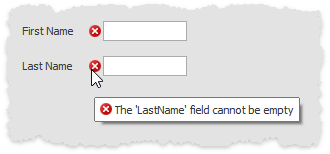ErrorInfo Class
Encapsulates error information on a specific property.
Namespace: DevExpress.XtraEditors.DXErrorProvider
Assembly: DevExpress.Data.v20.2.dll
NuGet Packages: DevExpress.Data, DevExpress.WindowsDesktop.Data
Declaration
Remarks
ErrorInfo objects are used to store error information on a business object’s properties. The ErrorInfo.ErrorText and ErrorInfo.ErrorType properties specify the error information.
Example
The following example demonstrates how to implement error notifications for a custom business object at the data source level, using the IDXDataErrorInfo interface. Error information will be handled by the DXErrorProvider component, which will indicate any error to an end-user.
In this example, the business object is represented by a custom MyRecord class. It contains two properties (FirstName and LastName) that cannot be empty. This class’ records are stored in a BindingSource component and edited using text editors (the FirstName and LastName properties are edited in a textEdit1 and textEdit2 controls respectively).
The requirement is to visually indicate errors within the editors, if the record’s FirstName or LastName property contain an empty string. In this example, the error information is provided on the data source level. The MyRecord class implements the IDXDataErrorInfo interface and returns the error information via the IDXDataErrorInfo.GetPropertyError method. To display the supplied errors within the editors, a DXErrorProvider component needs to be added to the form. It indicates errors as error icons, which can be hovered over to display error text.
To automatically track errors supplied by a data source, the DXErrorProvider component must be bound to this data source via the DXErrorProvider.DataSource property. In this example, the DXErrorProvider.DataSource property is set to the BindingSource.
The following image illustrates the resulting form after it has been opened at runtime. The editors contain empty strings, and as a result error icons are displayed within the editors:

using DevExpress.XtraEditors.DXErrorProvider;
private void Form1_Load(object sender, EventArgs e) {
// Specify the type of records stored in the BindingSource.
bindingSource1.DataSource = typeof(MyRecord);
// Create an empty MyRecord and add it to the BindingSource.
MyRecord rec = new MyRecord();
rec.FirstName = "";
rec.LastName = "";
bindingSource1.Add(rec);
// Bind the text editors to the MyRecord.FirstName and MyRecord.LastName properties.
textEdit1.DataBindings.Add(new Binding("EditValue", this.bindingSource1,
"FirstName", true));
textEdit2.DataBindings.Add(new Binding("EditValue", this.bindingSource1,
"LastName", true));
// Bind the DXErrorProvider to the data source.
dxErrorProvider1.DataSource = bindingSource1;
// Specify the container of controls (textEdit1 and textEdit2)
// which are monitored for errors.
dxErrorProvider1.ContainerControl = this;
}
//...
// A custom record class.
public class MyRecord : IDXDataErrorInfo {
private string firstName;
private string lastName;
public MyRecord() { }
public string FirstName {
get { return firstName; }
set { firstName = value; }
}
public string LastName {
get { return lastName; }
set { lastName = value; }
}
// Implements the IDXDataErrorInfo.GetPropertyError method.
public void GetPropertyError(string propertyName, ErrorInfo info) {
if (propertyName == "FirstName" && FirstName == "" ||
propertyName == "LastName" && LastName == "") {
info.ErrorText = String.Format("The '{0}' field cannot be empty", propertyName);
}
}
// IDXDataErrorInfo.GetError method
public void GetError(ErrorInfo info) { }
}